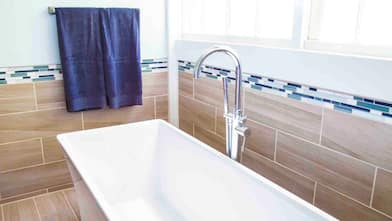Anticipate costs and stay one step ahead when budgeting for new flooring
Whether you’re decorating your first home, planning a full remodel, or freshening up your home’s interior, getting new flooring can be an exciting project. To ensure the process goes as smoothly as possible, you should plan out your budget and deliverables prior to the installation. Here are some key things to know when it comes to estimating your flooring expenses.
Typical Costs for New Flooring
The cost to install new flooring, according to HomeAdvisor, averages $3 to $22 per square foot, depending on the material and extent of the project. In total, it costs around $2,985 per 500 square feet to install new flooring. Your project’s final cost is determined by the amount of flooring you’re purchasing, installation materials, and any additional labor requests, repairs, or finishes.
Square Footage Calculations
Before your flooring professional arrives, you can calculate an important measure: your home’s square footage or the square footage of the rooms where you’ll be installing new flooring. With this information, you can determine which flooring materials and styles are the best options for your budget.
Here are the steps for calculating square footage:
Measure the length and width of each room and round to the nearest inch.
Convert your measurements of feet and inches to just feet. To do this, divide the total number of inches by 12, round up, and then add your result to the feet total.
Multiply the room’s length by its width, which will express the appropriate measure in square feet.
Note: If a room isn’t a perfect square or rectangle, you can split it into two or three separate areas to make measuring easier; then add their square feet totals together.
Floor Materials

The material you pick for your new floors will likely be one of the biggest cost factors. Luckily, there are several options, and you can find a flooring material that best suits your budget. Some of the most common types of flooring materials are ceramic or porcelain tile, bamboo or hardwood, laminate (or engineered wood), vinyl or linoleum, and carpet.
The most affordable option is laminate, which is very durable and has an easy installation process. The most costly option is typically tile, which is long-lasting and extremely water-resistant.
Solid Hardwood vs. Engineered Hardwood
If you’re thinking about going for wood flooring, you’ll have to decide whether you want solid or engineered hardwood. Solid hardwood, on one hand, is solid–this means that it’s entirely made of wood. Many homeowners love the beautiful and timeless look of hardwood flooring, but it can be susceptible to stains, scratches, and dents and dings.
On the other hand, engineered hardwood has a similar appearance but is much thinner and consists of less wood. This is why engineered hardwood is not as expensive as solid hardwood; however, it tends to be significantly less durable.
Factor in Underlayment
Another factor that goes into flooring estimates is underlayment. Underlayment is a spongy or plastic padding that goes underneath carpeting and absorbs potential spills.
Some flooring comes with the underlayment attached, while other times, you’ll have to purchase it separately. Underlay is usually sold by the bulk–in a roll–and the cost to install it ranges between $200 and $500.





